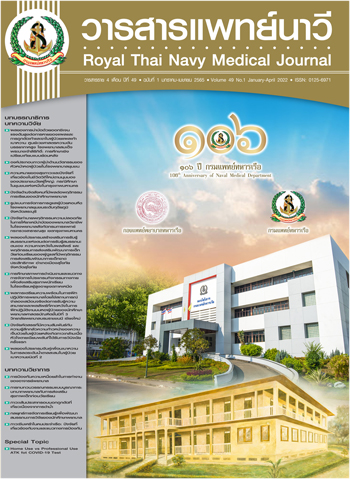Diving Related Neurapraxia
Main Article Content
Abstract
Diving related neurapraxia is an uncommon condition presenting with neurological symptoms such as numbness, tingling or weakness. Common causes are overpressure or barotrauma of the middle ear and the paranasal sinuses which usually affect the seventh cranial nerve known as Facial baroparesis and the fifth cranial nerve or Trigeminal paralysis, respectively. Direct compression of the nerve from diving equipment like tight wetsuit or lead belt could be the causes in some cases. Knowing this type of the injuries including understanding their mechanism with a complete history and clinical physical examination would help to get a prompt diagnosis. Decompression illness must be the first condition to be ruled out due to its requirement of recompression therapy. Normally, neurapraxia can be self-limited but in some cases, pharmacological treatments such as decongestants or doing some procedures, for example myringotomy to release the overpressure could be helpful. Recompression therapy is not recommended due to potential risk of worsening symptoms especially in case of neurapraxia caused from barotrauma.
Article Details

This work is licensed under a Creative Commons Attribution-NonCommercial-NoDerivatives 4.0 International License.
References
Brubakk AO, Neuman TS, editors. Bennett and Elliott’s physiology and medicine of diving. 5th ed. Cornwall: Saunders; 2003.
Edmonds C, Bennett M, Lippmann J, Mitchell SJ. Diving and subaquatic medicine. 5th ed. Florida: Taylor & Francis Group, LLC; 2016.
Vann RD, Butler FK, Mitchell SJ, Moon RE. Decompression illness. Lancet 2011; 377(9760):153-64.
Rosińska J, Łukasik M, Kozubski W. Neurological complications of underwater diving. Neurol Neurochir Pol 2015;49(1):45-51.
Newton HB. Neurologic complications of scuba diving. Am Fam Physician 2001;63(11): 2211-8.
Frans Cronjè. All that tingles is not bends. Divers Alert Network. [Internet]. [cited 2021 September 23]. Available from: https://alertdiver.eu/en_US/articles/all-that-tingles-is-not-bends.
Winn HR, editor. Youmans & Winn neurological surgery. 7th ed. Philadelphia, PA: Elsevier; 2017.
Biso GMNR, Munakomi S. Neuroanatomy, neurapraxia. [Internet]. [cited 2021 September 23]. Available from: https://www.ncbi.nlm.nih.gov/books/NBK557746/.
Cuello CMC, De Jesus O. Neurapraxia. [Internet]. [cited 2021 September 23]. Available from: https://www.ncbi.nlm.nih.gov/books/NBK560501/.
Brandt MT. Oral and maxillofacial aspects of diving medicine. Mil Med 2004;169(2):137-41.
Cooper JS, Hendriksen S, Hexdall EJ. Alternobaric facial paresis. [Internet]. [cited 2021 September 23]. Available from: https://www.ncbi.nlm.nih.gov/books/NBK470529/.
White R, Shackleton D. Plane palsy: a case of transient facial weakness during an aircraft flight. BMJ Case Rep 2018;2018. doi: 10.1136/bcr-2018-224593.
Wimmer MS, Ali TY. Transient unilateral facial nerve baroparesis with vertigo on ascent in the F-16CM. Aerosp Med Hum Perform 2016;87(2):141-3.
Le Carboulec L, De Mestier J, Boucenna M, Lecanu JB. Recurrent transient facial nerve palsy on commercial air flights. Eur Ann Otorhinolaryngol Head Neck Dis 2021;138(3):187-89.
Caffrey JP, Adams JW, Costantino I, Klepper K, Kari E, Brown LA. Successful treatment of highly recurrent facial baroparesis in a frequent high-altitude traveler: a case report. J Med Case Rep 2020;14(1):218.
Dulak D, Naqvi IA. Neuroanatomy, cranial nerve 7 (facial). [Internet]. [cited 2021 October 17]. Available from: https://www.ncbi.nlm.nih.gov/books/NBK526119/.
Baxter A. Dehiscence of the fallopian canal: an anatomical study. J Laryngol Otol 1971;85(6):587-94.
Ceponis P, Weaver LK, Churchill S. Facial nerve paralysis in a diver: a case report. Undersea and Hyperbaric Medicine 2017;44(2):161-5.
Kamide D, Matsunobu T, Shiotani A. Facial baroparesis caused by scuba diving. Case Rep Otolaryngol 2012;2012:329536.
Whelan TR. Facial nerve palsy associated with underwater barotrauma. Postgrad Med J 1990;66(776):465-6.
Hyams AF, Toynton SC, Jaramillo M, Stone LR, Bryson PJ. Facial baroparesis secondary to middle-ear over-pressure: a rare complication of scuba diving. J Laryngol Otol 2004;118(9):721.
Huff T, Daly DT. Neuroanatomy, cranial nerve 5 (trigeminal). [Internet]. [cited 2021 October 17]. Available from: https://www.ncbi.nlm.nih.gov/books/NBK482283/.
Murrison AW, Smith DJ, Francis TJ, Counter RT. Maxillary sinus barotrauma with fifth cranial nerve involvement. J Laryngol Otol 1991;105(3):217-9.
Butler FK, Bove AA. Infraorbital hypesthesia after maxillary sinus barotrauma. Undersea Hyperb Med 1999;26(4):257-9.
Schipke JD, Cleveland S, Drees M. Sphenoid sinus-related vision loss and scuba diving: a case report. Ann Sports Med Res 2016;3(8):1096.
Gunn DJ, O'Hagan S. Unilateral optic neuropathy from possible sphenoidal sinus barotrauma after recreational scuba diving: a case report. Undersea Hyperb Med 2013;40(1):81-6.
Hexdall EJ, Butler FK. Transient vision loss at depth due to presumed barotraumatic optic neuropathy. Undersea Hyperb Med 2012;39(5):911-4.
Garland MM, Gutrierrez A, Barratt DM. Peripheral neuropathy of the extremity after hyperbaric exposure. Aviat Space Environ Med 2012;83(8):805-8.
Greenhouse AH, Page K. Scuba diver's thigh. West J Med 1986;145(5):698-9.
Sander HW. Mononeuropathy of the medial branch of the deep peroneal nerve in a scuba diver. J Peripher Nerv Syst 1999;4(2):134-7.
Isakov AP, Broome JR, Dutka AJ. Acute carpal tunnel syndrome in a diver: evidence of peripheral nervous system involvement in decompression illness. Ann Emerg Med 1996;28(1):90-3.
Butler FK Jr, Pinto CV. Progressive ulnar palsy as a late complication of decompression sickness. Ann Emerg Med 1986;15(6):738-41.
Livingstone DM, Smith KA, Lange B. Scuba diving and otology: a systematic review with recommendations on diagnosis, treatment and post-operative care. Diving and Hyperbaric Medicine 2017;47(2):97-109.
Hussain G, Wang J, Rasul A, Anwar H, Qasim M, Zafar S, et al. Current states of therapeutic approaches against peripheral nerve injuries: a detailed story from injury to recovery. Int J Biol Sci 2020;16(1):116-34.


